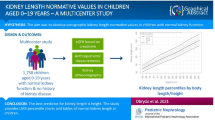Abstract
The pattern and distribution of subcutaneous fat in term and preterm newborns has been assessed by skinfold thicknesses (ST), describing gender and gestational age variations. Weight, length and ST (triceps, biceps, subscapular and suprailiac) were measured in 4634 neonates (2445 males and 2189 females) aged from 32 to 41 gestational weeks. Central to total skinfold ratio (CTS), (suprailiac + subscapular)/sum of 4 ST, was calculated. Males were heavier and longer than females. The sum of 4 ST and CTS was higher in females at every gestational age (with significant differences from 35 weeks) and also the sum of 4 ST per kg body weight (P<0.05 from 32–33 weeks). Throughout the gestational period, ST increased significantly (P<0.0001) but CTS did not show variations, neither in males nor in females. Conclusion: term and preterm females have a more centralised pattern and more amount of subcutaneous fat than males. Central to total skinfold ratio must be considered as an index of centripetal fat store which is independant of gestational age.
Similar content being viewed by others
Abbreviations
- BS :
-
biceps skinfold thickness
- CTS :
-
central to total skinfold ratio
- DXA :
-
dual energy X-ray absorptiometry
- FFM :
-
fat-free mass
- FM :
-
fat mass
- SBS :
-
subscapular skinfold thickness
- SPS :
-
suprailiac skinfold thickness
- ST :
-
skinfold thickness
- ΣST :
-
the sum of the four skinfolds (biceps, triceps, subscapular and suprailiac)
- TS :
-
triceps skinfold thickness
References
Boule NG, Tremblay A, Gonzalez J, Aguilar CA, Lopez JC, Depres JP, Buchard C, Gomez JF, Castillo L, Rios JM (2003) Insulin resistance and abdominal adiposity in young men with documented malnutrition during the first year of life. Int J Obes 27: 598–604
Brambilla P, Manzoni P, Sironi S, Simeone P, Del Maschio A, di Natale B, Chiumello G (1994) Peripheral and abdominal adiposity in childhood obesity. Int J Obes 18: 795–800
Butte NF, Hopkinson JM, Wong WW, Smith EO, Ellis KJ (2000) Body composition during the first 2 years of life: an updated reference. Pediatr Res 47: 578–585
Chang TC, Robson SC, Spencer JA (1993) Neonatal morphometric indices of fetal growth: analysis of observer variability. Early Hum Dev 35: 37–43
Copper RL, Goldenberg RL, Cliver SP, DuBard MB, Hoffman HJ, Davis RO (1993) Anthropometric assessment of body size differences of full-term male and female infants. Obstet Gynecol 81: 161–164
Deurenberg P, Pieters JJL, Hautvast JGAJ (1990) The assessment of the body fat percentage by skinfold thickness measurements in childhood and young adolescence. Br J Nutr 63: 293–303
Fox K, Peters D, Armstrong N, Sharpe P, Bell M (1993) Abdominal fat deposition in 11-year-old children. Int J Obes 17: 11–16
Gampel B (1965) The relation of skinfold thickness in the neonate to sex, length of gestation, size at birth and maternal skinfold. Hum Biol 37: 29–37
Guihard-Costa AM, Grangé G, Larroche JC, Papiernik E (1997) Sexual differences in anthropometric measurements in French newborns. Biol Neonate 72: 156–164
Guihard-Costa AM, Papiernik E, Grangé G, Richard A (2002) Gender differences in neonatal subcutaneous fat store in late gestation in relation to maternal weight gain. Ann Hum Biol 29: 26–36
Koo WWK, Walters JC, Hockman EM (2000) Body composition in human infants at birth and postnatally. J Nutr 130: 2188–2194
Krotkiewski M, Björntorp P, Sjöstrom L, Smith U (1983) Impact of obesity on metabolism in men and women. Importance of regional adipose tissue distribution. J Clin Invest 72: 1150–1162
Moreno LA, Fleta J, Mur L, Feja C, Sarría A, Bueno M (1997) Indices of body fat distribution in Spanish children aged 4.0 to 14.9 years. J Pediatr Gastroenterol Nutr 25: 175–181
Moreno LA, Fleta J, Sarría A, Rodríguez G, Gil C, Bueno M (2001) Secular changes in body fat patterning in children and adolescent of Zaragoza (Spain), 1980–1995. Int J Obes 25: 1656–1660
Moreno LA, Pineda I, Rodríguez G, Fleta J, Sarría J, Bueno M (2002) Waist circumference for the screening of the metabolic syndrome in children. Acta Paediatr 91: 1307–1312
Pulzer F, Haase U, Knupfer M, Kratzsch J, Richter V, Rassoul F, Kiess W, Keller E (2001) Serum leptin in formerly small-for-gestational-age children during adolescence: relationship to gender, puberty, body composition, insulin sensitivity, creatinine, and serum uric acid. Metabolism 50: 1141–1146
Rigo J, Nyamugabo K, Picaud JC, Gerard P, Pieltain C, De Curtis M (1998) Reference values of body composition obtained by dual energy X-ray absorptiometry in preterm and term neonates. J Pediatr Gastroenterol Nutr 27: 184–190
Sardinha LB, Going SB, Teixeira PJ, Lohman TG (1999) Receiver operating characteristic analysis of body mass index, triceps skinfold thickness, and arm girth for obesity screening in children and adolescents. Am J Clin Nutr 70: 1090–1095
Sarría A (1992) Methods for assessing fat patterning in children. In: Hernández M, Argente J (eds) Human growth: basic and clinical aspects. Elsevier, Amsterdam, pp 233–243
Schmelzle HR, Fusch C (2002) Body fat in neonates and young infants: validation of skinfold thickness versus dual-energy X-ray absorptiometry. Am J Clin Nutr 76: 1096–1100
Singhal A, Weels J, Cole TJ, Fewtrell M, Lucas A (2003) Programming of lean body mass: a link between birth weight, obesity, and cardiovascular disease? Am J Clin Nutr 77: 726–730
Taylor RW, Gold E, Manning P, Goulding A (1997) Gender differences in body fat content are present well before puberty. Int J Obes 21: 1082–1084
Weststrate JA, Deurenberg P (1989) Body composition in children: proposal for a method for calculating body fat percentage from total body density or skinfold-thickness measurements. Am J Clin Nutr 50: 1104–1115
Westrate J, Deurenberg P, van Tinteren H (1989) Indices of body fat distribution and adiposity in Dutch children from birth to 18 years of age. Int J Obes 13: 465–478
Author information
Authors and Affiliations
Corresponding author
Rights and permissions
About this article
Cite this article
Rodríguez, G., Samper, M.P., Ventura, P. et al. Gender differences in newborn subcutaneous fat distribution. Eur J Pediatr 163, 457–461 (2004). https://doi.org/10.1007/s00431-004-1468-z
Received:
Accepted:
Published:
Issue Date:
DOI: https://doi.org/10.1007/s00431-004-1468-z




